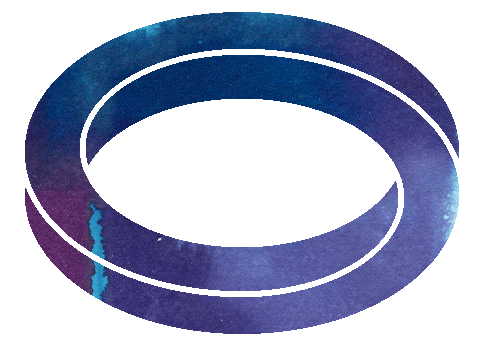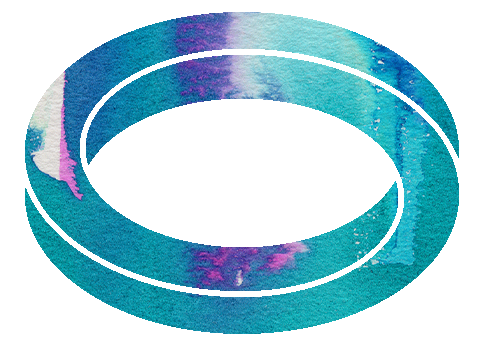We say we aren’t the ones conducting the treatment. We defer to a therapeutic agency more potent than our own will. Yet our education teaches us to follow the narrative arc of a session and to discern its features. “Is this a Neutral or a Stillpoint?” “Is this the Fluid Tide or the Long Tide?”
I believe this potential incongruence — even call it a paradox — explains why my students think they have to exert extra effort to understand, remember, and take session notes. They don’t know which things to notice. They try to notice everything. They complain that naming phenomena and recording notes pulls them out of stillness.
As students, we learn about the Fluid Tide, Long Tide, and Dynamic Stillness. We want to witness the healing taking place. We want to accurately name biodynamic phenomena.
Most of us approach our Biodynamic sessions the same way we learned to approach any modality: We separate from our client to observe our client. But Biodynamic perception relies on us not separating. In fact, pulling away from the client to sense and name what’s happening is like asking a satellite dish to pick out which bits of information it wants to receive.
At first it can be hard work to receive information without filtering. But our job is to be effortlessly aware, without categorizing, choosing, or analyzing the information. Very much like the satellite.
You think you must use effort to make yourself aware. That’s not true. Effort always restricts your awareness and you need to see how you are restricting it. It is natural and effortless to be completely aware, but you interfere. It is our nature to be aware. (A.H. Almaas, Diamond Heart Book 2, p. 117)

What does this metaphor of the satellite mean in actual practice? It means that to master Biodynamic Craniosacral sessions — and then write up our notes — we must become seamless with awareness itself.
I’m not asking students to be a someone who notices. I’m asking them to record what awareness already noticed.
You don’t have to exert any effort to hear a sound. That is precisely what it’s like to conduct a biodynamic session. Awareness is already hearing, seeing, feeling, and knowing.
“You” are not observing the session from a control tower. You are submerged in awareness, and synced with awareness. You are awareness.
If you sit in meditation and an ambulance goes by, you don’t exert any effort to hear the siren. After the period of meditation, you probably recall the sound of the ambulance. If you didn’t hear it, it’s likely that awareness was so expanded that it wasn’t perturbed by the sound — and that tells you something meaningful about the meditation. Similarly, if you are anxious in meditation, you’ll remember that your nervous system was agitated; it’s not complicated or subtle to note that you didn’t settle.
It’s precisely the same with observing your client’s session. Let’s say their dense, brittle tissue body is bathed in shimmers of potency. Inertial condensations expand, buoyancy fills the area, and a sense of calm prevails. Just as you can report a movie after watching it, you can name the storyline of a session, because awareness was there watching all along.
A great movie is a movie you forget you’re watching. You forget about the popcorn in your lap and the bills you have to pay. Attention is not split. Awareness is wholly absorbed in the movie.
A session has the same effortless quality. You aren’t divided into the one perceiving and the one perceived. You are in the action. When the Neutral gets wobbly, you’re cultivating your own Neutral. When the body expands from Tissue to Fluid, you experience the relief of it, the beauty, and the expansion.
The session itself is not always easy and effortless…But awareness of what happens is effortless.

A practitioner must avoid probing into our client to acquire information about our client. We simply report what arises in our own awareness. There’s no guarantee that our experience is synchronous with our client’s. But often there’s congruence. The more we refine both our Neutral and subtle perception, the more confidence we gain that there is a relationship between what arises in awareness and our client’s experience. Over time, we correlate what we feel with what’s happening in our client. Baseline examples:
- If the practitioner didn’t notice any phenomena, because we were asleep or submerged in stillness, that in itself is meaningful. In that case, I would put my money on the client being asleep or still.
- If the practitioner experienced vigilance, frustration, or fixation (but didn’t enter the session that way), that is also meaningful. Even if the practitioner experienced the challenge in reference to our own thoughts and emotions (which is most likely), the client is also almost surely vigilant, frustrated, or fixated. Often the client’s comments later will indicate that they grappled with the same flavor or even similar content as “my own” experience.
- If the practitioner was in a state of ease, flow, and intuitive guidance, it suggests that the client was in Fluid Tide, even if the particulars of the flow are not accessible after the session or expressible in words.
As a clinician writing up notes after a Fluid Tide session, I won’t be able to put into language the vibrant, multi-linear particulars of the swirling fractal patterns. But I will recall the coherence of the unified bodymind; the dense yet buoyant feel of the fluid body’s substance; the tempo of the Fluid Tide’s flow; or a feeling of being contained within the room, with no awareness of the skin’s boundary.
In such a session, I might record that my inner eye saw three-dimensional fractals, which I felt palpably participated in the client’s healing process. My hands might feel the shoulder buzzing with an injury. I might be aware of an empathic throbbing in my own neck. I might sense subtle motion patterns working in that spot, and ultimately feel the pain dissipating — in both my body or the client’s.
For a clinically effective session, is it essential that the practitioner identify these impressions accurately? Absolutely not! But if I do, then they can soothe my mind, keep me grounded in the client’s reality, and create a scaffolding for therapeutic actions.
Knowing, for example, that the client achieved a Neutral, I know that they will be receptive to Primary Respiration and more likely to heal from their symptoms. Or knowing that they experienced the Fluid Tide, I can encourage them to explore this new quality of embodiment, even though in their communication with me, they’re emphasizing the vulnerability that this newfound openness has brought.
Knowing and naming in the Long Tide and Dynamic Stillness are less likely to be confusing; because there’s less of a practitioner to get in the way. More on that in a future post.

So on the one hand, except for training purposes, naming what happens in a session doesn’t matter. The person who names the phenomena is not conducting the treatment. And in any case the phenomena in question are spontaneous, novel, multidimensional and impossible to pin down. Awareness itself doesn’t distinguish between, say, spontaneous flow and inertial fulcra; or between a weak fluid drive and a robust one.
On the other hand, though, naming is an essential skill. As part of a Biodynamic education, we learn to recognize (that is, perceptually tease apart) the nuances of stillness and of meaningful motion patterns.
Labeling biodynamic phenomena can be a blessing and a curse.
The curse of naming:
- My mind might mistakenly think during the session that I’m asking it to analyze or interpret what’s happening.
- If narrow my gaze to what I deem “wrong” (the inertia), I may energize the inertial pattern instead of supporting its resolution.
- When I inadvertently focus on inertia, it reinforces my client’s understandable fixation on what hurts or what needs tending to — which can keep them locked into those very patterns.
The blessing of naming:
- Perception is key to engagement. The whole point of biodynamics is that my own ability to perceive the enfoldments of Fluid Tide, Long Tide, and Dynamic Stillness — to be aware of these embodied states of consciousness — facilitates them for the client.
- It’s clinically valuable to be aware of specific phenomena, too, not just enfoldments. If you recognize a Stillpoint, you’re less likely to interrupt it by moving to a different contact as it builds power. If you observe that the dreamy, coherent flow that arose was the Fluid Tide, then you realize that the session went beyond relaxation to portend therapeutic effectiveness.
- The client benefits when the practitioner is aware of things, parts, symptoms, or movements. Sure, awareness resolves inertia inherently. But the practitioner’s personal knowledge can be both catalyst and support. If I have studied cranial bones, then the ethmoid can communicate its distress to me more clearly; whereas you might be more adept with acupuncture points or trigger points. As Jim Jealous said, “A visible segment is a segment in trouble.”
- Our ability to name phenomena supports the client’s conscious awareness of them. When, after the table work, we subtly guide clients to discover the session’s impact, they better understand the value of the work. They can make the changes conscious and therefore more vivid. And they are better able to sustain the transformational effects. But the practitioner has to have a framework — language — to be able to have that conversation. (That doesn’t mean using jargon with our clients. See a previous blog post, Beyond Vagueness, for how I use the client’s own comments to frame our work together.)
I’d love to hear any contributions to this topic from you! There’s so much to say that this piece got way too long, even though I axed large chunks of what I wrote. How about you? In your experience, is naming efferent or afferent? Helpful or unhelpful? What do you aspire to perceive, that is, name? What kind of session notes do you take? How do you experience this paradox in our field around knowing…yet not knowing?

BE THE FIRST TO HEAR
ABOUT UPCOMING EVENTS
AND PUBLICATIONS.
Unsubscribing is always available with a single click.